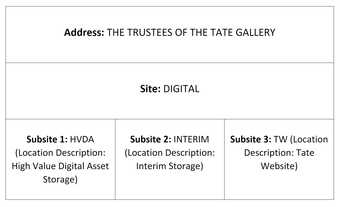Web-based components: Context and reasoning

Fig.1
Young-Hae Chang Heavy Industries
THE ART OF SLEEP 2006 (video still)
Web-based video, black and white, and sound (stereo)
Duration: 18 min, 30 sec
Tate
© YOUNG-HAE CHANG HEAVY INDUSTRIES

Fig.2
Young-Hae Chang Heavy Industries
Detail from THE ART OF SILENCE 2006 (video still)
Web-based video, black and white, and sound (stereo)
Duration: 13 min, 52 sec
Tate
© YOUNG-HAE CHANG HEAVY INDUSTRIES
In 2021 Tate formally acquired its first two works of net art, Young-Hae Chang Heavy Industries’s THE ART OF SLEEP and THE ART OF SILENCE (figs.1–2). These works were created in 2006 and form part of a group of fifteen net artworks commissioned by Tate for its website between 2000 and 2011.1 Both consist of black capitalised text appearing on a white background, accompanied by a soundtrack of jazz beats; the text in each work plays on the language and structures of the art world. From the point that these two works entered the Tate collection they have been on ‘permanent’ display via their artwork webpages on museum’s website.2
An essential element in the composition of net artworks is their web-based components. In the case of THE ART OF SLEEP and THE ART OF SILENCE, the web-based components are the media files – also known as exhibition formats – that enable their display via Tate’s website. These net artworks formed a case study for the research project Reshaping the Collectible: When Artworks Live in the Museum (2018–22), and during this research it became apparent that Tate’s application of its collection management system – The Museum System (TMS) – was unable to accurately document the location of these components.3 Firstly, no suitable location pre-existed within TMS. The second and more fundamental issue was that the extant configuration and structure of Tate’s location hierarchies would not support the straightforward creation of a new suitable location. By existing convention, the structure of locations on TMS for Tate sites are dependent on and originate with physical location, each beginning with a core site (for example, Tate Britain or Tate Store) with a stratification of specified physical locations layered beneath (for example: Tate Britain → Store → bay → shelf). While it is anticipated that web-based components can be situated on identifiable servers, these may not be fixed to a single physical site, and therefore existing locational structures would be inappropriate for these types of components.
Due to their nature as net artworks, ongoing online accessibility is fundamental to the Young-Hae Chang Heavy Industries works. As such, it is essential that they are displayed ‘permanently’ via Tate’s website. When considering these unusual ‘permanent’ display circumstances, these works’ display sits outside of Tate’s conventional structures for exhibitions and displays as they are not shown in a designated physical space for a specified period of time. As a result, their display would not be included in the exhibition or display records that are created to document and coordinate this type of collection activity. Therefore, the importance of recording the accurate ‘on display’ location of exhibition format components is further reinforced as this is the sole documented evidence of their display within Tate’s collection management system. The effective use of TMS to capture and document this type of display information greatly mitigates the risk of losing this knowledge from institutional memory. It also performs a key role in helping Tate to satisfy its responsibility to accurately document the display histories of artworks within its collection. To adequately contribute to an artist’s catalogue raisonné, Tate must be able to clearly state when and where an artwork was on display; TMS’s inability to locate web-based components limited Tate’s capacity to do this for this new type of artwork in Tate’s collection.

Fig.3
Yinka Shonibare
The British Library 2014
6,328 books, Dutch wax print fabric, gold foil, software, networked, world wide web, table and chairs
Overall display dimensions variable
© Yinka Shonibare. Co-commissioned by HOUSE 2014 and Brighton Festival. Courtesy the artist and Stephen Friedman Gallery, London
The inability of Tate’s application of TMS to locate web-based components has not only affected net artworks, as there are other works in the collection that contain web-based components, an example being Yinka Shonibare’s The British Library 2014 (fig.3). This mixed media installation consists of tangible elements – 6,328 hardback books individually covered in bespoke fabric and arranged on shelving within the gallery space, along with a table and chairs – and an equally fundamental live website element. The work is considered to be ‘on display’ when both the physical elements are exhibited and the live website is active and accessible via the internet. When The British Library is not on display, a standing webpage is accessible but does not allow audience engagement – as such, the standing webpage does not constitute the work being classified as ‘on display’. The work was on display at Tate Modern from March 2019 to April 2022 and the exhibition format component that represents the live website was un-located on TMS during this time due to a lack of a suitable location.
Digital components and digital storage
As of the publishing of this essay in 2022, web-based artwork components within the Tate collection, or those soon to be acquired, only constitute a small number. However, as Tate’s capacity to collect net art evolves – combined with the identification of net art within Tate’s acquisitions development policy – this number can be expected to grow as additional net artworks or artworks containing a web-based element are acquired in the future. The process of reflecting on the locating of web-based components within TMS helpfully drew attention to another absence within Tate’s use of its collection management system, as the existing locational structures also did not allow the locating of digital components that are not stored on an individual hard drive or storage device.4
Before exploring this subject in greater depth, it is useful to briefly examine the background of Tate’s storage and management of digital components – a strategy coordinated by Tate’s Time-Based Media (TiBM) Conservation team. Tate has, in the past, utilised a combined approach to the storage of digital components, relying on a storage server managed by its Technology department and individual hard drives and data tapes stored alongside other media in collection stores. This approach was initiated in 2010 when a Digital Repository server was created that was located at Tate Britain together with the rest of Tate’s server infrastructure. A Tate Britain-rooted TMS location was created at this point to locate the digital components stored on the server. The Digital Repository server had limited capacity and was never intended for the long-term storage of all digital components, as a more extensive strategy existed to create a more sustainable and secure long-term digital storage solution. Digital components for only forty-two artworks were located on the server, which became full partway through 2011. The Digital Repository became defunct in March 2017 and all digital artwork components were removed at this time. The TiBM Conservation team continued to utilise a combination of hard drives, data tapes and an Interim Storage server, which represented the first phase of the implementation of a new High Value Digital Asset (HVDA) storage system. At that time, Tate’s use of TMS and its existing locational structures and hierarchy did not allow the locating of components stored on the Interim Storage server.
In light of these circumstances, twinned with the inability to locate web-based components, three digital storage TMS locations have been created to accommodate the anticipated locations that all digital components will be located within. These three locations are Interim Storage, HVDA Storage and the Tate website.
Interim Storage
- The Interim Storage server will continue to be used as a staging area for digital components, in anticipation of the movement of components to the next storage location, the HVDA system. In this respect, the Interim Storage plays an important role in the acquisitions process as digital components of time-based media artworks are placed on this server to maintain a second copy of the digital files received as part of an acquisition. This duplicative step is taken to ensure the retention and safety of these components against the risk of loss or failure of the carrier that is supplied as part of the acquisition. During the final stages of the acquisitions process, these digital components are quality controlled, archived and clearly documented within their long-term storage solutions.
- The Interim Storage is located on a single server based solely at Tate Store, and back-ups are made by the Technology team each day. This storage alone does not meet the requirements of a HVDA system and it is not intended for the long-term storage of digital components.
HVDA Storage
- The HVDA Storage sits across multiple sites, with servers (or equivalent non-server storage devices) situated in three locations, with Tate Britain and Tate Store having at least one server each. Two different forms of storage technology are employed.
- In accordance with HVDA specifications, ingested digital components are copied across all three servers (or equivalent non-server storage devices), and their integrity is automatically checked over time. The risk of loss of integrity at one site is mitigated through the replication of components across the three storage sites.
- The HVDA Storage is currently in the implementation phase. The hardware infrastructure has been sourced and built by the Technology team, while the TiBM Conservation team worked with Canadian software company Artefactual to develop and test the software environment required to safely store and access digital files in the long term.5
Tate website
- This location is intended to represent a display location for web-based components and would be used for works that will be displayed via Tate’s website, as well as microsites managed by Tate, such as the website for Shonibare’s The British Library.
- At present, Tate’s main website is hosted on multiple external servers by a third-party company, while The British Library microsite, for example, was hosted by a Tate Britain server. These web-based components do not sit within the HVDA or Interim Storage infrastructures and therefore a distinct location was required.
A large number of digital components located on Interim Storage, plus the small number of components displayed through Tate’s website, have remained un-located on TMS without the creation of the new locations. This number can fairly be expected to steadily grow as additional time-based media artworks are collected by Tate. Meanwhile, the ongoing migration of digital components onto the fully implemented HVDA Storage will amount to thousands of individual components, which, in turn, form part of hundreds of distinct artworks. Developing Tate’s utilisation of TMS to accurately locate digital components has greatly aided Tate’s documentation of these types of component and has reinforced Tate’s auditing compliance. It has allowed Tate to state precisely where each artwork component is located in an identical fashion to the tangible artwork components in the Tate collection. In terms of collection management, un-located digital components were an area of least compliance: a concern that would be exacerbated if the necessary locational structures were not introduced to accommodate the implementation of the HVDA Storage.
A new TMS location structure
The locations outlined in fig.4 (below) were developed for the creation of a new TMS location structure for digital components. The new structure rejected the suitability of creating additional subsites at an existing core Tate location (for example, Tate Britain or Tate Store) due to the digital nature of the components and their capacity to be located on servers across multiple physical locations. For instance, a component located on the HVDA Storage will simultaneously sit on digital storage devices across a number of physical sites.

Fig.4
The hierarchy of storage locations within which each digital component sits
Example 1: the live website component for The British Library would be located as:
T15250.028, THE TRUSTEES OF THE TATE GALLERY, DIGITAL, TW [The Trustees of the Tate Gallery, Digital, Tate Website] [22-Mar-2019], on display
Example 2: an archival master component for THE ART OF SLEEP would be located as:
T15753.004, THE TRUSTEES OF THE TATE GALLERY, DIGITAL, HVDA [The Trustees of the Tate Gallery, Digital, High Value Digital Asset Storage] [29-Jul-2019], not on display
Tracking and updating the movement of digital components
In order to comply with its auditing responsibilities for managing part of the UK’s national collection, Tate is required to have in place robust and effective procedures for tracking the location and movement of its collection. Tate employs various methods to capture the essential information associated with each artwork component move: object number, artist name, component name, component number, movement location, date of move and the names of the individuals who completed the movement. One of the key mechanisms at Tate for recording and tracking this information is the use of hard-copy journals that monitor the in or in/out movement of components within a defined physical space. For example, each individual store at Tate Store has its own journal for logging the movement of every artwork component that is moved into the store or within the store’s boundaries. The journals are then used to update artwork component locations on TMS.
As the development and implementation of Tate’s digital storage has created new storage locations, they will require their own mechanism (or an adaption of an existing mechanism) for tracking the movement of components into or within these locations. Due to the digital nature of the components, the creation of new location sites and, in the case of the HVDA Storage, the simultaneous storage of components across three sites, it would be inappropriate to expand the usage of an existing store/location journal. As of August 2022, the new mechanism is in the process of being developed and various options are under review.
